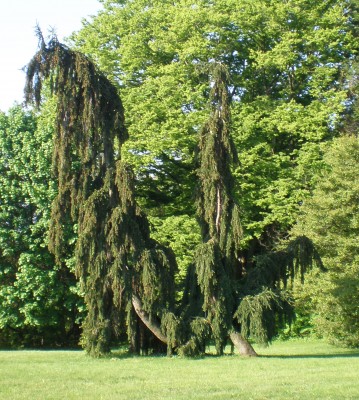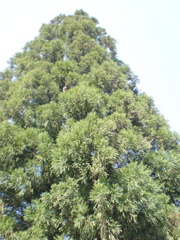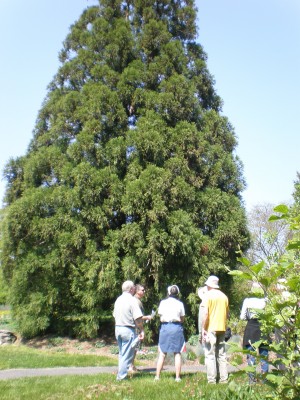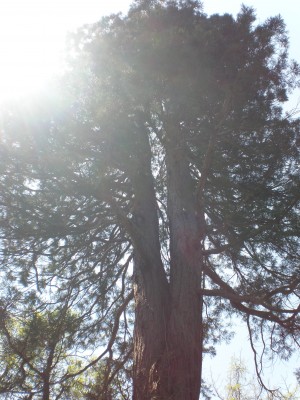State Champion Trees
This past week Scott Wade, State Coordinator of the Champion Tree Program for Pennsylvania, gave the Arboretum Assistants, the Scott Arboretum volunteers, a tour of state championship trees in the region. Just like the heritage trees of the Scott Arboretum, many of these state champion trees were planted as a result of the Quaker appreciation and reverence for nature.
The first stop on our tour was the Delaware County Community College where we visited the remains of a mid-1800s garden. One of my favorite champions in this 19th century Quaker garden was “Sir Spuce,” nicknamed for its similarity to a knight on a horse. Picea abies ‘Pendula’ is the state champion with a circumference of 4′ 1″, height of 31.6′, spread of 33′, for a total of 90 points.
The State Champion Tree point scale can be explained as follows:
Pennsylvania Big Tree Points = Height (feet) + Circumference Breast Height (inches) + 1/4 Maximum Crown Spread
Adding these three measurements together will give you the total points. As Scott Wade explained, the scale does favor short, fat trees, but it is the method used by most champion tree programs.
In addition to “Sir Spruce,” this garden holds a majestic Zelkova serrata, Japanese zelkova. This tree is often used as a street tree and can be found planted along Chester Road at the Scott Arboretum. The state champion tree has a circumference of 23′ 1″, height of 92′, spread of 90′, and 392 total points.
Our next stop, Pendle Hill cultivates what is believed to be a William Penn original charter plant. This is a tree originally surveyed by William Penn. This magnificent Fagus grandifloria, American beech, has a circumference of 21′ 8″, height of 92′, spread of 101′, and 378 total points.
To experience many champion trees in one place visit our sister arboretum, Tyler Arboretum. There you can see champion Cedrus libani, cedar-of-lebanon; Cryptomeria japonica ‘Yoshino’, Japanese cedar; Sequoiadendron giganteum, giant sequoia; and many more.
Anyone can nominate a state champion tree. Visit www.pabigtrees.com to nominate a tree or simply see a list of the current champions. The Scott Arboretum currently has a second place champion tree American elm, Ulmus americana, growing next the SEPTA train tracks below the fraternity houses.
After this tour, we believe the Scott Arboretum has many more champions but we simply need to go through the nomination process. Feel free to nominate your favorite tree and in the meantime Sue Stark is going to take Scott Wade on a tour to discover the Scott Arboretum’s champion trees.









Dan
Posted at 02:04h, 17 MayThis is a great post about champion trees. I love that “Sir Spruce” tree, it has a lot of character!
Gerri
Posted at 08:41h, 01 JuneThanks for documenting so much of what we saw and heard. It was an amazing educational jaunt.
Ken
Posted at 00:09h, 02 SeptemberRevised
Hello,
Please review:
Pennsylvania Big Tree Points = Height (feet) + Circumference Breast Height (inches) + 1/4 Maximum Crown Spread
But American Forest has seems to be a different equation listing 1/4 Average Crown Spread instead of 1/4 Maximum Crown Spread. Please review if these are different measurements?
Thanks
ken
Trunk Circumference + Height + 1/4 Average Crown Spread = Total Points
http://www.americanforests.org/resources/bigtrees/measure.php
ro mccarthy
Posted at 17:46h, 17 JuneI have a japaneese cedar tree in my yard. It is approximately 40 feet high. very healthy. Could you give me some information on this tree. I purchased a property with the existing tree and am having a difficult time finding out about this tree.
Andrew Bunting
Posted at 09:13h, 18 JuneIt sounds like you have the Japanese red-cedar, Cryptomeria japonica. This tree will grow equally well in sun or shade. You will notice that it does shed interior branches on a regular basis. Those can be removed as they fall. You should me mindful that cryptomeria can be susceptible to spider mites. It you notice your planting turning slightly yellow in the summer then do an inspection for spider mites.
Andrew Bunting, Curator
Scott Arboretum